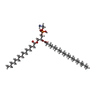+検索条件
-Structure paper
| タイトル | Conformational changes in the Niemann-Pick type C1 protein NCR1 drive sterol translocation. |
|---|---|
| ジャーナル・号・ページ | Proc Natl Acad Sci U S A, Vol. 121, Issue 15, Page e2315575121, Year 2024 |
| 掲載日 | 2024年4月9日 |
 著者 著者 | Kelly M Frain / Emil Dedic / Lynette Nel / Anastasiia Bohush / Esben Olesen / Katja Thaysen / Daniel Wüstner / David L Stokes / Bjørn Panyella Pedersen /   |
| PubMed 要旨 | The membrane protein Niemann-Pick type C1 (NPC1, named NCR1 in yeast) is central to sterol homeostasis in eukaryotes. NCR1 is localized to the vacuolar membrane, where it is suggested to carry ...The membrane protein Niemann-Pick type C1 (NPC1, named NCR1 in yeast) is central to sterol homeostasis in eukaryotes. NCR1 is localized to the vacuolar membrane, where it is suggested to carry sterols across the protective glycocalyx and deposit them into the vacuolar membrane. However, documentation of a vacuolar glycocalyx in fungi is lacking, and the mechanism for sterol translocation has remained unclear. Here, we provide evidence supporting the presence of a glycocalyx in isolated vacuoles and report four cryo-EM structures of NCR1 in two distinct conformations, named tense and relaxed. These two conformations illustrate the movement of sterols through a tunnel formed by the luminal domains, thus bypassing the barrier presented by the glycocalyx. Based on these structures and on comparison with other members of the Resistance-Nodulation-Division (RND) superfamily, we propose a transport model that links changes in the luminal domains with a cycle of protonation and deprotonation within the transmembrane region of the protein. Our model suggests that NPC proteins work by a generalized RND mechanism where the proton motive force drives conformational changes in the transmembrane domains that are allosterically coupled to luminal/extracellular domains to promote sterol transport. |
 リンク リンク |  Proc Natl Acad Sci U S A / Proc Natl Acad Sci U S A /  PubMed:38568972 / PubMed:38568972 /  PubMed Central PubMed Central |
| 手法 | EM (単粒子) |
| 解像度 | 2.43 - 3.3 Å |
| 構造データ | EMDB-18350, PDB-8qeb: EMDB-18351, PDB-8qec: EMDB-18352, PDB-8qed: EMDB-18353, PDB-8qee: |
| 化合物 |  ChemComp-Y01:  ChemComp-ERG:  ChemComp-HOH:  ChemComp-Q7G:  ChemComp-PTY:  ChemComp-NAG: |
| 由来 |
|
 キーワード キーワード | MEMBRANE PROTEIN / sterol transport / vacuole / lysosome / LIPID TRANSPORT |
 ムービー
ムービー コントローラー
コントローラー 構造ビューア
構造ビューア 万見文献について
万見文献について












